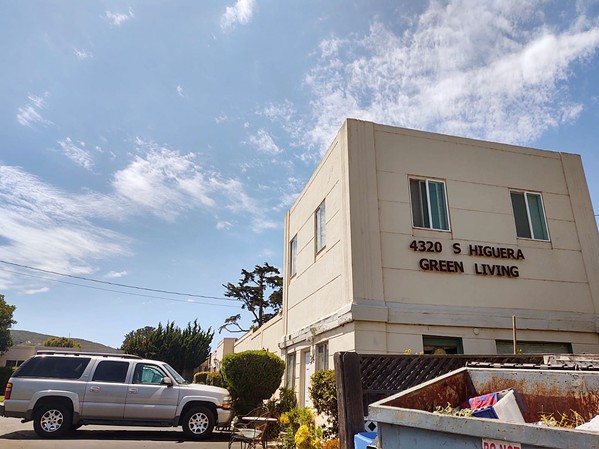Higuera Apartments will gain safe drinking water through SLO annexation with the help of the state water board
By Bulbul Rajagopal[{
"name": "Newsletter Promo",
"id": "NewsletterPromo",
"class": "inlineCenter",
"insertPoint": "4",
"component": "15264767",
"requiredCountToDisplay": "0"
},{
"name": "Ad - Medium Rectangle CC01 - 300x250",
"id": "AdMediumRectangleCC01300x250",
"class": "inlineCenter",
"insertPoint": "8",
"component": "2963441",
"requiredCountToDisplay": "12"
},{
"name": "Ad - Medium Rectangle LC01 - 300x250",
"id": "AdMediumRectangleCC01300x250",
"class": "inlineCenter",
"insertPoint": "18",
"component": "2963441",
"requiredCountToDisplay": "22"
},{
"name": "Ad - Medium Rectangle LC09 - 300x250",
"id": "AdMediumRectangleLC09300x250",
"class": "inlineCenter",
"insertPoint": "28",
"component": "3252660",
"requiredCountToDisplay": "32"
}]
After suffering from water contamination for nearly seven years, a disadvantaged apartment community in unincorporated San Luis Obispo County could find respite under the city of SLO's wing.
The SLO City Council unanimously voted on June 18 to annex the 3-acre South Higuera Street lot that houses a 24-unit apartment complex connected to a single nitrate-polluted well. The city will consolidate Higuera Apartments—4320 South Higuera St., south of Los Osos Valley Road—and its 30 residents so that they can connect to SLO's safer water and wastewater systems instead.
"I actually have been on the premises when I was looking for—this was a couple of years ago—low-cost housing for our oldest grandson," City Councilmember Jan Marx said at the meeting. "Finally, it came down to the water situation in terms of, 'Is this really going to work for us?' I do feel that it's a great asset to the community."
Labeled a "disadvantaged community"—meaning its residents annually earn less than 80 percent of the statewide median household income—Higuera Apartments also contains potentially forbidden structures, including two detached single-family homes and two trailers, plus sheds, storage containers, and a ground-mounted solar panel system with unidentified permit records.
City annexation will snap Higuera Apartments into compliance by securing permits to update or remove the structures altogether. By hooking up the property to its water system, SLO stands to make headway in its goal to provide diverse housing options to its constituents.
The annexation of Higuera Apartments helps advance a goal for the state too. It's one of 10 failing water systems in SLO County serving a total of almost 1,500 people that the State Water Resources Control Board keeps an eye on through its sustainable drinking water program.
Called the Safe and Affordable Funding for Equity and Resilience, or SAFER, the drinking water program is a combination of tools, funding, and regulatory authorities used by the state water board to achieve environmental justice. According to the SAFER database, 390 public water systems across California are failing, 547 others are at risk, and 468 systems are potentially at risk for water quality, accessibility, affordability, and "technical managerial financial capacity" reasons.
"Groundwater contamination isn't unique, and a small water system that's struggling to implement a drinking water solution, that's not unique either," SAFER Section Supervising Engineer Chad Fischer told New Times on June 21. "Somewhat unique is the relative close proximity to a large water system. That's a pretty fortunate set of circumstances for Higuera Apartments that there is a large utility very close by and that the opportunity exists to connect to that entity."
Cooperation is also a novel aspect of the Higuera Apartments annexation project, according to Fischer.
"The city accepting the application for annexation and the state board being able to provide funds for both drinking water and sewer ... I think that things are aligning here," he said.
The state water board is providing technical and financial assistance to Higuera Apartments property owner Ronald Schriner. It's able to help because of the SAFER Fund that arrived in 2019 with the signing of Senate Bill 200. That bill requires the fund to be created through an annual transfer of 5 percent of the Greenhouse Gas Reduction Fund up to $130 million until June 30, 2030.
With $97,000 allotted for the state water board's initial 2022 work plan budget to consolidate Higuera Apartments with SLO for drinking water, the sum rose to nearly $140,000 last July after a budget increase. So far, the water board has spent $111,903 and is anticipating a work plan amendment containing planning and design tasks.
Fischer told New Times that Higuera Apartments' contaminated water system appeared on the state water board's radar after SLO County's Environmental Health Division issued property owner Schriner a compliance notice in 2021 stemming from the violations. The enforcement document triggered the failing status of the nitrate-contaminated water system.
City documents show that the first documented instance of pollution in the Higuera Apartments well occurred in 2017 with a nitrate contamination level of 13 milligrams per liter (mg/L). That's three units higher than the maximum contaminant level for primary drinking water standards, according to the California Code of Regulations. While a water sample from the well in 2019 showed that the nitrate level dropped to 6.1 mg/L, samples collected in February and March of 2021 displayed higher concentrations of 12 mg/L. By December 2021, another test showed that pollution level rose to 14.4 mg/L.
"Nitrate levels can fluctuate," Fischer said. "[It depends on the] time of year, or the amount of pumping, or the certain period of the drought cycle we're in. There isn't one answer. ... It just isn't predictable or reliable to say it would probably go down because of X or Y."
The age of the well system remains unknown. The system is located across the street from Higuera Apartments and uses two 85-gallon pressure tanks at the well head. A connecting 1 1/2-inch distribution line under South Higuera Street supplied water to its residents. The technical memorandum prepared by environmental consultant Weber, Hayes, and Associates said that the water system has no storage or backup power, and the distribution system piping and other elements are almost at the end of their shelf life.
Schriner has been supplying Higuera Apartments residents with bottled water ever since contamination was identified.
Neither he nor the county responded to New Times' requests for comment by press time.
Higuera Apartments has added help through the SAFER Fund. The state water board's funding is flexible enough to bring on third-party technical assistance providers who provide analytical work on behalf of failing water systems. For Higuera Apartments and Schriner, the Sacramento State Office of Water Programs filed the application for annexation after it identified consolidation as the preferred permanent solution to providing safe and reliable water.
"Prior to 2019, we didn't really have that ability. These small, disadvantaged communities would have to go out and try to hire folks on their own," Fischer said.
The city of SLO also identified that it has enough water to accommodate Higuera Apartments. It currently uses water at the rate of 5,000 acre-feet per year. With an estimated maximum annual water demand of 2.1 acre-feet per year, Higuera Apartments is expected to use only 0.08 percent of the available 2,500 acre-feet of water allocated for community growth through 2035.
Annexing and helping Higuera Apartments opens up new opportunities for the city.
"The city would be eligible for certain financial incentives ... provided by the state water board for capital projects," SLO Associate Planner Hannah Hahn told the City Council on June 18. "They include interest-free loans and refinancing of existing loans."
Utilities Deputy Director of Water Mychal Boerman added that Higuera Apartments' designation as a disadvantaged community in the voluntary consolidation process creates the possibility for the city to receive around $240,000 in grant funding and up to $10 million in zero percent interest loans.
City staff is now reviewing annexation request, incorporating an environmental review and a plan for services, and ironing out a pre-annexation agreement. The Planning Commission and the City Council will conduct public hearings after the review before the annexation request is eventually sent to the Local Agency Formation Commission for approval. Δ
Reach Staff Writer Bulbul Rajagopal at [email protected].
Latest in News
Comments (2)
Showing 1-2 of 2
Readers also liked…
-

SLO police identify alleged driver who hit and killed couple
Dec 22, 2022 -

When the levee breaks: Oceano residents, county officials walk a tightrope of regulations to manage Arroyo Grande Creek, which some say led to the levee's failure in January
May 18, 2023 -

Cal Poly report highlights offshore wind's potential to spur green energy transition
Jun 8, 2023










